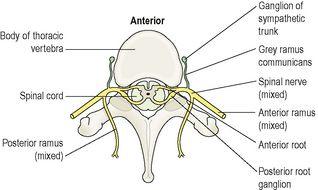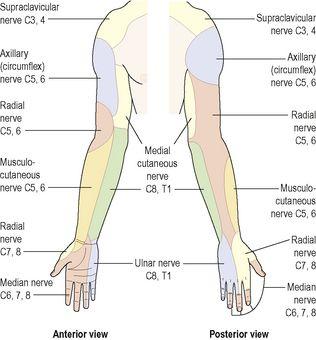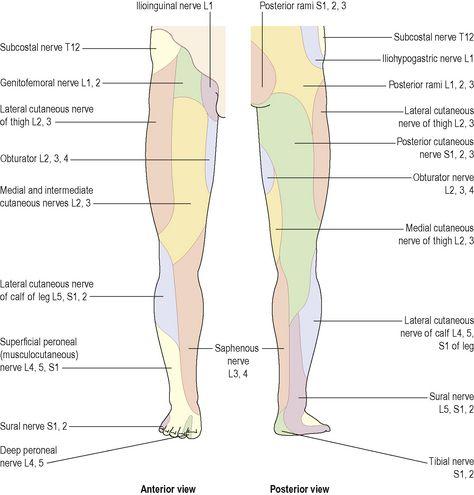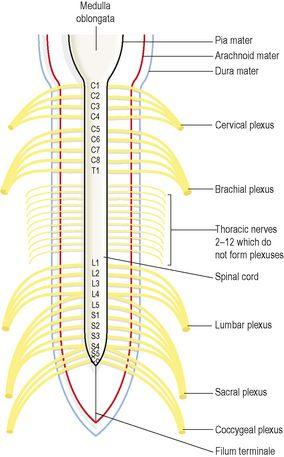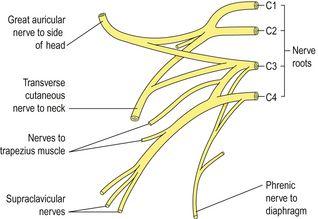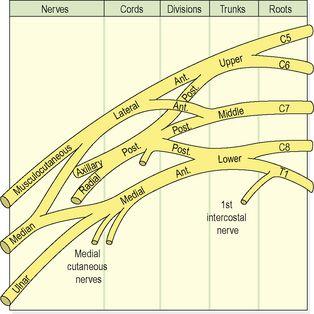Ross & Wilson Anatomy and Physiology in Health and Illness (74 page)
Read Ross & Wilson Anatomy and Physiology in Health and Illness Online
Authors: Anne Waugh,Allison Grant
Tags: #Medical, #Nursing, #General, #Anatomy

This part of the nervous system consists of:
•
31 pairs of spinal nerves
•
12 pairs of cranial nerves
•
the autonomic nervous system.
Most of the nerves of the peripheral nervous system are composed of sensory nerve fibres transmitting afferent impulses from sensory organs to the brain, and motor nerve fibres transmitting efferent impulses from the brain to the effector organs, e.g. skeletal muscles, smooth muscle and glands.
Spinal nerves
There are 31 pairs of spinal nerves that leave the vertebral canal by passing through the intervertebral foramina formed by adjacent vertebrae. They are named and grouped according to the vertebrae with which they are associated (see
Fig. 7.28
):
•
8 cervical
•
12 thoracic
•
5 lumbar
•
5 sacral
•
1 coccygeal.
Although there are only seven cervical vertebrae, there are eight nerves because the first pair leaves the vertebral canal between the occipital bone and the atlas and the eighth pair leaves below the last cervical vertebra. Thereafter the nerves are given the name and number of the vertebra immediately
above
.
The lumbar, sacral and coccygeal nerves leave the spinal cord near its termination at the level of the 1st lumbar vertebra, and extend downwards inside the vertebral canal in the subarachnoid space, forming a sheaf of nerves which resembles a horse’s tail, the
cauda equina
(see
Fig. 7.28
). These nerves leave the vertebral canal at the appropriate lumbar, sacral or coccygeal level, depending on their destination.
Nerve roots (
Fig. 7.32
)
The spinal nerves arise from both sides of the spinal cord and emerge through the intervertebral foramina (see
Fig 16.26
,
p, 396
). Each nerve is formed by the union of a
motor
(anterior) and a
sensory
(posterior)
nerve root
and is, therefore, a
mixed nerve
. Thoracic and upper lumbar (L1 and L2) spinal nerves have a contribution from the sympathetic part of the autonomic nervous system in the form of a
preganglionic fibre
.
Figure 7.32
The relationship between sympathetic and mixed spinal nerves.
Sympathetic nerves in green.
Chapter 16
describes the bones and muscles mentioned in the following section. Bones and joints are supplied by adjacent nerves.
The
anterior nerve root
consists of motor nerve fibres, which are the axons of the lower motor neurones from the anterior column of grey matter in the spinal cord and, in the thoracic and lumbar regions,
sympathetic nerve fibres
, which are the axons of cells in the lateral columns of grey matter.
The
posterior nerve root
consists of sensory nerve fibres. Just outside the spinal cord there is a
spinal ganglion
(posterior, or dorsal, root ganglion), consisting of a little cluster of cell bodies. Sensory nerve fibres pass through these ganglia before entering the spinal cord. The area of skin whose sensory receptors contribute to each nerve is called a
dermatome
(see
Figs 7.37
and
7.41
).
Figure 7.37
The distribution and origins of the cutaneous nerves of the arm.
Figure 7.41
Distribution and origins of the cutaneous nerves of the leg.
For a very short distance after leaving the spinal cord the nerve roots have a covering of
dura
and
arachnoid maters
. These terminate before the two roots join to form the mixed spinal nerve. The nerve roots have no covering of pia mater.
Branches
Immediately after emerging from the intervertebral foramen, spinal nerves divide into branches, or
rami
: a ramus communicans, a posterior ramus and an anterior ramus.
The rami communicante
are part of preganglionic sympathetic neurones of the autonomic nervous system.
The posterior rami
pass backwards and divide into smaller medial and lateral branches to supply skin and muscles of relatively small areas of the posterior aspect of the head, neck and trunk.
The anterior rami
supply the anterior and lateral aspects of the neck, trunk and the upper and lower limbs.
Plexuses
In the cervical, lumbar and sacral regions the anterior rami unite near their origins to form large masses of nerves, or
plexuses
, where nerve fibres are regrouped and rearranged before proceeding to supply skin, bones, muscles and joints of a particular area (
Fig. 7.33
). This means that these structures have a nerve supply from more than one spinal nerve and therefore damage to one spinal nerve does not cause loss of function of a region.
Figure 7.33
The meninges covering the spinal cord, spinal nerves and the plexuses they form.
In the thoracic region the anterior rami do not form plexuses.
There are five large plexuses of mixed nerves formed on each side of the vertebral column. They are the:
•
cervical plexuses
•
brachial plexuses
•
lumbar plexuses
•
sacral plexuses
•
coccygeal plexuses.
Cervical plexus (
Fig. 7.34
)
This is formed by the anterior rami of the first four cervical nerves. It lies deep within the neck opposite the 1st, 2nd, 3rd and 4th cervical vertebrae under the protection of the sternocleidomastoid muscle.
Figure 7.34
The cervical plexus.
Anterior view.
The superficial branches
supply the structures at the back and side of the head and the skin of the front of the neck to the level of the sternum.
The deep branches
supply muscles of the neck, e.g. the sternocleidomastoid and the trapezius.
The phrenic nerve
originates from cervical roots 3, 4 and 5 and passes downwards through the thoracic cavity in front of the root of the lung to supply the diaphragm, initiating inspiration. Disease or spinal cord injury at this level will result in death due to apnoea without assisted ventilation.
Brachial plexus
The anterior rami of the lower four cervical nerves and a large part of the 1st thoracic nerve form the brachial plexus.
Figure 7.35
shows its formation and the nerves that emerge from it. The plexus is situated deeply within the neck and shoulder above and behind the subclavian vessels and in the axilla.

